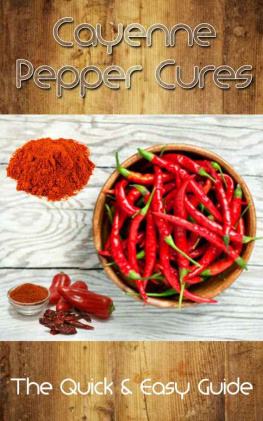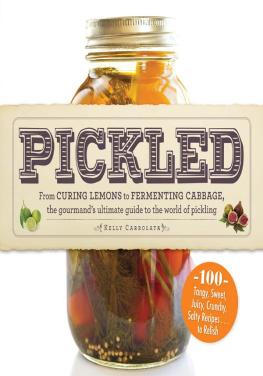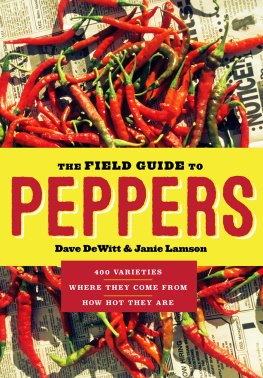Cumberland - Cayenne Pepper Cures: The Quick & Easy Guide
Here you can read online Cumberland - Cayenne Pepper Cures: The Quick & Easy Guide full text of the book (entire story) in english for free. Download pdf and epub, get meaning, cover and reviews about this ebook. year: 2014, genre: Home and family. Description of the work, (preface) as well as reviews are available. Best literature library LitArk.com created for fans of good reading and offers a wide selection of genres:
Romance novel
Science fiction
Adventure
Detective
Science
History
Home and family
Prose
Art
Politics
Computer
Non-fiction
Religion
Business
Children
Humor
Choose a favorite category and find really read worthwhile books. Enjoy immersion in the world of imagination, feel the emotions of the characters or learn something new for yourself, make an fascinating discovery.
- Book:Cayenne Pepper Cures: The Quick & Easy Guide
- Author:
- Genre:
- Year:2014
- Rating:3 / 5
- Favourites:Add to favourites
- Your mark:
- 60
- 1
- 2
- 3
- 4
- 5
Cayenne Pepper Cures: The Quick & Easy Guide: summary, description and annotation
We offer to read an annotation, description, summary or preface (depends on what the author of the book "Cayenne Pepper Cures: The Quick & Easy Guide" wrote himself). If you haven't found the necessary information about the book — write in the comments, we will try to find it.
Cayenne Pepper Cures: The Quick & Easy Guide — read online for free the complete book (whole text) full work
Below is the text of the book, divided by pages. System saving the place of the last page read, allows you to conveniently read the book "Cayenne Pepper Cures: The Quick & Easy Guide" online for free, without having to search again every time where you left off. Put a bookmark, and you can go to the page where you finished reading at any time.
Font size:
Interval:
Bookmark:
Cayenne Pepper Cures:
The Quick and Easy Guide
Table of Contents
- Introduction
- Chapter 1- A General Overview
- Chapter 2- Medicinal Uses of Cayenne Pepper
- Chapter 3- Cayenne Pepper Diet for Weight Reduction
- Conclusion
Introduction
I want to thank you and congratulate you for downloading the book, Cayenne Pepper Cures: The Quick and Easy Guide .
This book features proven tips and strategies on how to use cayenne pepper as a natural remedy for some common illnesses .
Cayenne pepper is a perennial shrub which grows to about 100 cm in height. The plant thrives in warm climate and well-drained sandy soil. It has a woody stem with several branches is covered with dark green leaves.
Cayenne is a red or orange herb that has a spicy taste. It is a common addition to recipes to add flavor and heat to food. Herbalists believe that this herb has healing properties and have extensively used it for many years. Among its benefits include boosting immunity, cleansing the body, and combating ailments like ulcers and common colds. In more recent years, this herb has also made the headlines for its weight loss effects. A weight reduction diet called The Master Cleanse prominently features cayenne pepper as the key ingredient to successfully cleansing the body and promoting weight loss.
This book contains comprehensive information on cayenne pepper and its many health benefits. It also contains a guide on how to make a cayenne pepper tea with lemon, water, and ample helpings of cayenne for a healthy drink. This information will help you achieve your health objectives with the aid of cayenne peppers amazing medicinal benefits.
Thanks again for downloading this book, I hope you enjoy it!
Copyright 2014 by ______________________ - All rights reserved.
This document is geared towards providing exact and reliable information in regards to the topic and issue covered. The publication is sold with the idea that the publisher is not required to render accounting, officially permitted, or otherwise, qualified services. If advice is necessary, legal or professional, a practiced individual in the profession should be ordered.
- From a Declaration of Principles which was accepted and approved equally by a Committee of the American Bar Association and a Committee of Publishers and Associations.
In no way is it legal to reproduce, duplicate, or transmit any part of this document in either electronic means or in printed format. Recording of this publication is strictly prohibited and any storage of this document is not allowed unless with written permission from the publisher. All rights reserved.
The information provided herein is stated to be truthful and consistent, in that any liability, in terms of inattention or otherwise, by any usage or abuse of any policies, processes, or directions contained within is the solitary and utter responsibility of the recipient reader. Under no circumstances will any legal responsibility or blame be held against the publisher for any reparation, damages, or monetary loss due to the information herein, either directly or indirectly.
Respective authors own all copyrights not held by the publisher.
The information herein is offered for informational purposes solely, and is universal as so. The presentation of the information is without contract or any type of guarantee assurance.
The trademarks that are used are without any consent, and the publication of the trademark is without permission or backing by the trademark owner. All trademarks and brands within this book are for clarifying purposes only and are the owned by the owners themselves, not affiliated with this document.
Chapter 1: Cayenne Pepper A General Overview
Cayenne pepper is also commonly called as bird pepper, aleva, cow-horn pepper, Guinea spice, or red pepper (particularly in its powdered form). This type of pepper is among the thousands of Capsicum cultivars grown all around the world. It is related to paprika, jalapenos, and bell peppers among others. The genus Capsicum belongs to the family Solanacea. Cayenne pepper is a hot chili pepper which is used to add flavor to meals. Its name was derived from the city of Cayenne in French Guiana.
Most commonly, the fruits of the cayenne plant are dried and ground. They may also be pulped and baked and formed into cakes, which are then ground and sifted to create a spice in powdered form with the same name.
Cayenne pepper is utilized in the preparation of spicy meals, in its whole form or as a powder. It is popular in Sichuan, Korean, and other Asian cuisine. It may also be used as an additional flavoring in thin, vinegar-based sauces. According to the Scoville units, cayenne is rated 30,000 to 50,000 units in terms of heat. It may also be utilized as an herbal remedy, which was promoted in the book Complete Herbal written by Nicholas Culpeper in 1653 as guinea pepper, a misnomer for Guiana pepper.
Capsicum annuum, the most commonly grown varieties of cayenne, can be cultivated in different locations and require only about 100 days to mature. Peppers thrive well in moist and nutrient-abundant soil in a warm climate. In general, the plants grow to around 39 inches long in height and must be spaced about 1 meter apart.
These plants are basically perennial in tropical and subtropical regions; although, they are commonly cultivated as annuals in temperate regions. If protected from frost, chilies can be overwintered; although they may need some pruning.
Nutrition
Cayenne pepper contains considerable amounts of vitamin A. It also contains manganese, potassium, riboflavin, vitamin C, vitamin E and vitamin B6. Taking into consideration the minute amounts of cayenne that is usually consumed in a serving, it makes an almost negligible contribution to the entire dietary consumption of such nutrients.
The consumption of cayenne pepper speeds up the metabolism and dilates the blood vessels because of the high amounts of capsaicin. When cayenne pepper is consumed, the amount of heat that the human body releases is affected. In recent studies involving animals, capsaicin was reported to have the ability to increase metabolism which results to weight reduction. This boosts circulation and blood flow to the major organs which promotes better nutrient and oxygen delivery.
Cayenne pepper may promote a healthy balance of energy while suppressing the appetite. It has also been reported to boost the expenditure of energy, so it serves as a metabolism booster and is helpful in long-term weight reduction. It has also been reported that there is a link between capsaicin and oxidation. Treatment with capsaicin was shown to sustain fat oxidation during weight maintenance, but did not have an impact on weight regain.
Cayenne pepper was also reported to function as an aphrodisiac since it contains capsaicin. In addition to this, cayenne pepper has been indicated to help in the oxidation of adipose tissue, encourage healthy production of mucus in the membranes that line the internal organs, help regulate the digestive system, regulate tissue production and liver function and help regulate high blood pressure.
Nutrition Facts Cayenne Pepper | |
Amount per 100 grams | |
Calories 318 | |
Percent Daily Value | |
Total Fat 17 grams | 26% |
Saturated fat 3.3 grams | 16% |
Polyunsaturated fat 8 grams | |
Monosaturated fat 2.8 grams | |
Cholesterol 0 milligrams | 0% |
Sodium 30 milligrams | 1% |
Potassium 2,014 milligrams | 57% |
Total Carbohydrate 57 grams |
Font size:
Interval:
Bookmark:
Similar books «Cayenne Pepper Cures: The Quick & Easy Guide»
Look at similar books to Cayenne Pepper Cures: The Quick & Easy Guide. We have selected literature similar in name and meaning in the hope of providing readers with more options to find new, interesting, not yet read works.
Discussion, reviews of the book Cayenne Pepper Cures: The Quick & Easy Guide and just readers' own opinions. Leave your comments, write what you think about the work, its meaning or the main characters. Specify what exactly you liked and what you didn't like, and why you think so.










